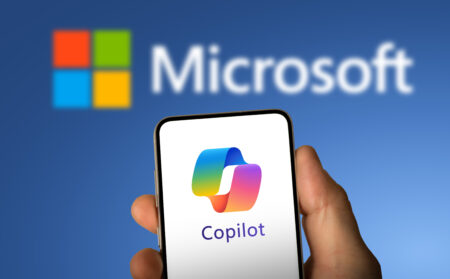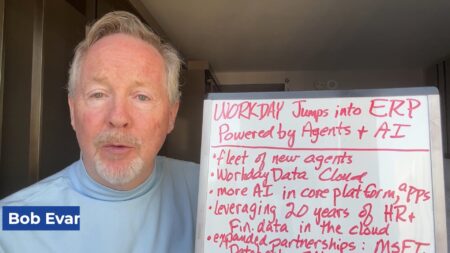While Oracle’s sprawling ambitions and product lines continue to mark every enterprise-software company as a competitor, founder Larry Ellison recently specified that the future of the entire company (Oracle) will be determined by the fortunes of its Cloud ERP SaaS service and its self-driving Autonomous Cloud Database.
 “Oracle has two strategic products that will determine our future,” Ellison said in opening his prepared remarks during Oracle’s recent earnings call with analysts.
“Oracle has two strategic products that will determine our future,” Ellison said in opening his prepared remarks during Oracle’s recent earnings call with analysts.
“Our Cloud ERP product is the strategic key to our success in the SaaS applications layer of the cloud, and our Autonomous Cloud Database is the strategic key to our success in the IaaS or infrastructure layer of the cloud.”
And in those few sentences, Ellison revealed a great deal about Oracle’s current priorities and intentions:
- With about half of Oracle’s $39 billion in annual revenue coming from its flagship database franchise, Ellison is clearly betting that a huge percentage of Oracle’s hundreds of thousands of database customers will not only move those databases to the cloud, but will choose Oracle’s one-of-a-kind self-driving cloud database.
- Ellison is attempting to tie Oracle’s potential in the public-cloud infrastructure space—where Oracle, relative to IaaS leader Amazon and second-place Microsoft, currently has negligible market share—to the Autonomous Cloud Database as the determining factor that business customers will use in the future.
- Ellison is continuing to stand alone in claiming that the ERP sector is the largest and most-influential of all the enterprise-applications sectors—a claim that’s absolutely essential to his assertion about the impact Cloud ERP will have in the future. Research firm Gartner, as well as enteprise-software rivals Salesforce and SAP, all make the case that it’s the CRM segment—which Salesforce currently dominates—that’s the largest of the three major enterprise-apps categories (the third is HCM).
Because each of those themes has sweeping competitive ramifications within the tech sector, and because each can also have profound implications on the decisions that business customers make when choosing cloud providers, let’s take a closer look at each.
Oracle strategic product #1: Autonomous Cloud Database. I find it fascinating that almost a full year after Oracle introduced its self-driving database with great internal fanfare, no other major database players have chosen to tout the autonomous angle as a primary differentiator. Now, there could be many reasons for that, but here are the two that matter most:
It’s possible that—as Ellison claims—Oracle has a near-insurmountable lead in autonomous-database technology of such magnitude that the other top database providers—led by Microsoft, IBM and Amazon—aren’t yet willing or able to step forward and lay down a competitive claim.
It’s also possible that other database vendors are finding that business customers are not as enthralled as Oracle is with the self-driving concept, and are therefore intentionally steering clear of getting into an autonomous arms race with Oracle that won’t result in a big revenue payoff.
Ellison’s betting the company on self-driving database as IaaS game-changer. “In the IaaS, or infrastructure layer of the Cloud, we have the world’s most popular, and technically, most advanced database, the Oracle Autonomous Database,” Ellison said in his earnings-call prepared remarks.
“Even our biggest competitors use it to run their businesses: Salesforce.com uses Oracle to run their sales-automation cloud, SAP uses the Oracle Database to run their cloud services and nearly all their on-premise customers, and even Amazon uses the Oracle Database to run most of their business.”
And that performance superiority will extend directly into the IaaS marketplace and upend the current competitive dynamics, Ellison went on to say.
“Now that the Oracle Autonomous Database is running in our second-generation Bare-Metal cloud infrastructure, customers can both lower their labor costs and cut their Amazon bill in half by running the Oracle Database on Oracle Cloud Infrastructure. The Oracle Autonomous Database automatically patches itself while running to prevent data theft—no other database can do that,” Ellison said.
“We think these compelling advantages will allow us to compete very effectively against Amazon in the infrastructure business. Today, we may be behind Amazon in infrastructure market share but we are way ahead of Amazon in cloud infrastructure technology. We think that will allow us to gain market share in infrastructure in the Cloud very, very rapidly.”
Will leadership in Cloud ERP translate to the outsized impact Ellison described? “Oracle is already number one in Cloud ERP market share, with over 20,000 Fusion and NetSuite customers,” Ellison said (about two-thirds or more of those customers came from Oracle’s acquisition of NetSuite two years ago).
He went on to describe a two-pronged approach for the Cloud ERP market—and in doing so, Ellison refers to Oracle’s internally created product as “Fusion ERP” to differentiate it from NetSuite or from cloud versions of on-premises apps such as JD Edwards or E-Business Suite.
“Customers are buying Fusion ERP to replace their existing SAP on-premise ERP systems, and customers are buying Fusion ERP to replace their existing Workday Cloud ERP systems,” said Ellison.
While it’s certainly possible that Oracle’s Cloud ERP business is winning some SAP on-premises customers as well as some converts from Workday Financials, both SAP and Workday report growth rates of 30 percent or more for their own cloud ERP businesses, so at least as of now those incursions don’t appear to be significant.
Ellison then described how leadership in cloud ERP would give Oracle overall leadership in SaaS as a complement to the future growth he described in the IaaS layer.
“ERP is the largest segment in the application business,” Ellison said. “Continuing our rapid growth in the Cloud ERP market puts Oracle well on its way to becoming the world’s largest SaaS applications company.”
So: what to make of all this?
Oracle’s created a very solid position for itself in the Cloud Wars, but at times its rhetoric about what it is going to do gets way out of phase with what it has in fact actually achieved.
*******************
RECOMMENDED READING FROM CLOUD WARS:
The World’s Top 5 Cloud-Computing Suppliers: #1 Microsoft, #2 Amazon, #3 Salesforce, #4 SAP, #5 IBM
Amazon Versus Oracle: The Battle for Cloud Database Leadership
As Amazon Battles with Retailers, Microsoft Leads Them into the Cloud
Why Microsoft Is #1 in the Cloud: 10 Key Insights
SAP’s Stunning Transformation: Qualtrics Already “Crown Jewel of Company”
Watch Out, Microsoft and Amazon: Google Cloud CEO Thomas Kurian Plans To Be #1
The Coming Hybrid Wave: Where Do Microsoft, IBM and Amazon Stand? (Part 1 of 2)
Oracle, SAP and Workday Driving Red-Hot Cloud ERP Growth Into 2019
*********************
On top of that, while Ellison’s depictions of his own company’s capabilities and potential might be right on the mark, he often portrays his competitors as being frozen in time, either unable or unwilling to undertake innovation and disruption on the very same scale that Oracle is projecting for itself.
But relative to the actions and achievements in the cloud from Amazon, SAP and Workday, those claims from Oracle are not carrying much weight, particularly among business customers from around the world that are driving the huge cloud-revenue growth rates at Amazon, SAP, Workday and others.
Subscribe to the Cloud Wars Newsletter for twice-monthly in-depth analysis of the major cloud vendors from the perspective of business customers. It’s free, it’s exclusive, and it’s great!








